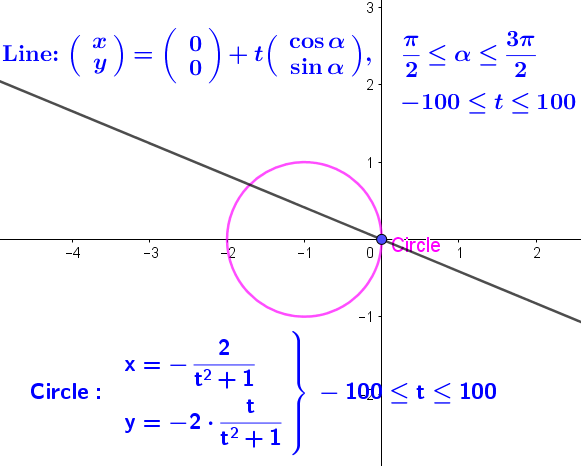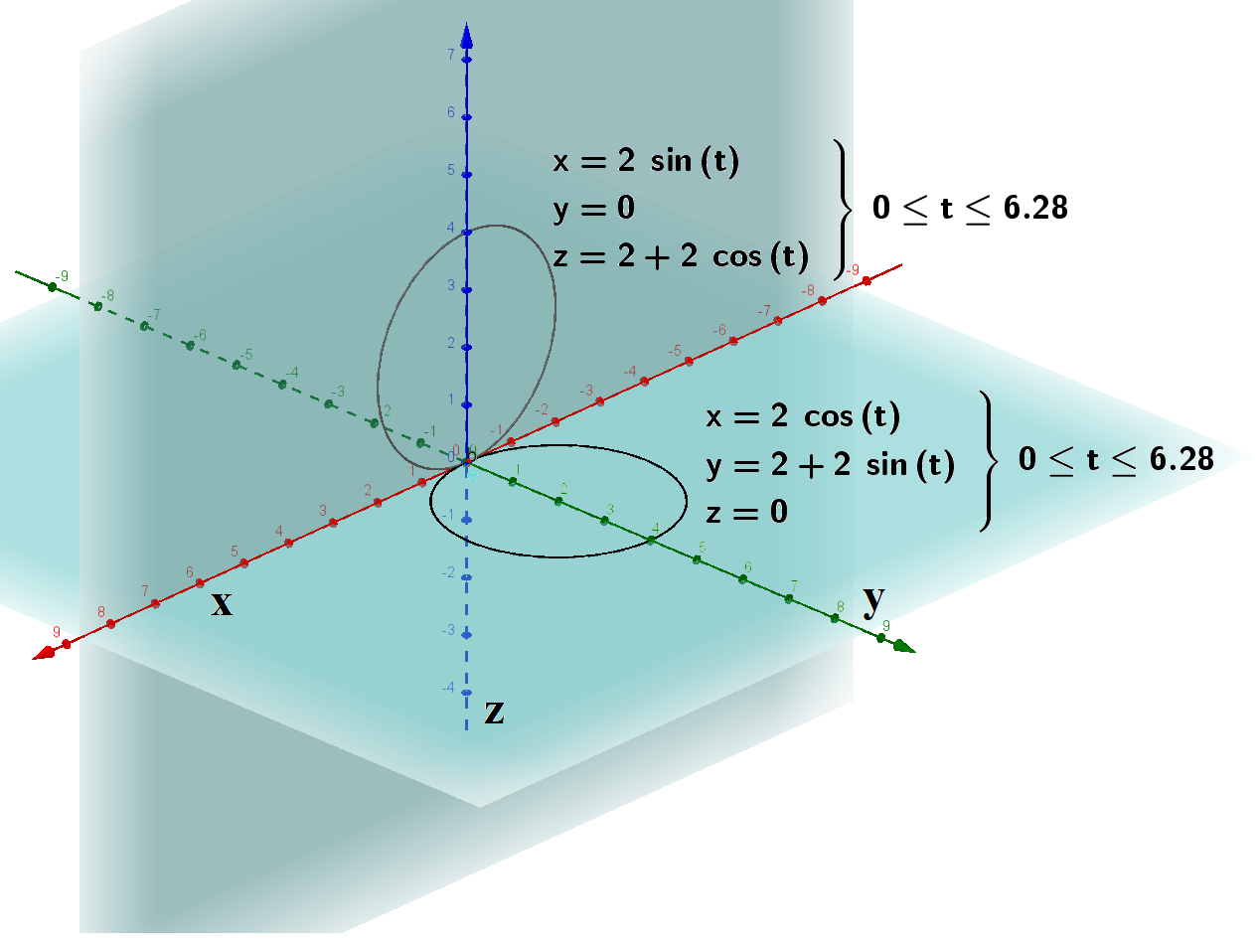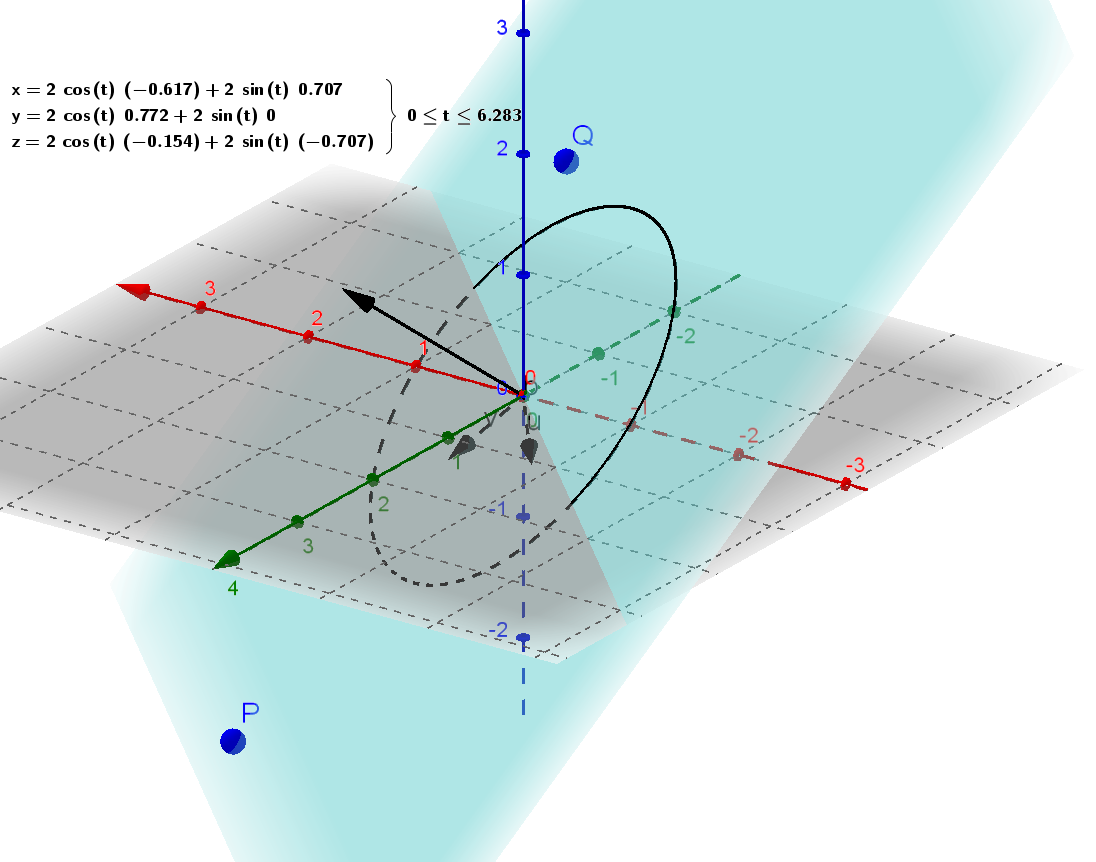Parametrization of a Circle
There are many ways to parameterize a circle. A quick online search should turn up at least a few. Therefore, we must not assume that what is presented here is the only parametrization because it isn't. What's more, depending on the application, this might not be the right one to use. I would venture that this trig parametrization is the most common.
When we talk about “plane” geometry, the plane that is standard is called the (x,y) plane, but it is represented in 3d as the equation $$0x+0y+1z=0$$ That is, $x$ and $y$ can take on any value, but the $z$ coordinate will always be zero. We have already said in a page about parameters that the circle in the plane can be represented by $$Circle=\binom{r\cdot\cos(\theta)}{r\cdot\sin(\theta)}. \tag{1} \label{1}$$ It doesn't take much exploration to discover that the center of the circle can be used to offset the parameters as $$Circle=\binom{h}{k}+\binom{r\,\cos(\theta)}{r\,\sin(\theta)}$$ where $(h,k)$ represent the center point. When $\theta$ is varied in equation $\eqref{1}$ from $0$ to $2\pi$ the points of the circle are constructed going counter-clockwise. In order to get them going around clockwise, we can just change the sign of the $r\,\sin(\theta)$ term. $$\text{Clockwise Circle}=\left(\begin{array}{c} r\cdot\cos(\theta)\\ -r\cdot\sin(\theta) \end{array}\right).$$
Line Parametrization of a Circle
Another, and way less common, way to paramtrize a circle is to locate a point on the circle and then any line that goes through the point will intersect the circle. As the line is rotated about our point, the locus of all possible intersections describes the circle. It doesn't matter where the circle is located, nor what size it is, only that the point chosen is on the circle and that the line is constructed in the same plane that has the circle.
- Write the line equation: $y-P_y=m(x-P_x)$ and since $P=(0,0),$ $y=mx$
- Write the circle equation: $(x+1)^{2}+y^{2}=1.$
- Solve the two equations simultaneously to yield expressions for $x$ and $y$ in terms of $m$ and some constants: \[ \left(\begin{array}{c} x\\ y \end{array}\right)=f(m)=\left(\begin{array}{c} \frac{2}{m^{2}+1}\\ \frac{-2m}{m^{2}+1} \end{array}\right),\quad-100\le m\le100 \]

3-dimensional coordinates in a plane
What if we wanted to draw the unit circle, into the same plane $(z=0)$ , but to do so using 3-dimensional coordinates? Then, the parametrization could be, $$Circle=\left(\begin{array}{c} h\\ k\\ \lambda \end{array}\right)+\left(\begin{array}{c} r\,\cos(\theta)\\ r\,\sin(\theta)\\ 0 \end{array}\right)$$ Now if we just modify these a bit, we can see a circle drawn in another plane, say $0x+1y+0z=0$ and its equation can be, $$\text{Vertical Circle}=\left(\begin{array}{c} h\\ k\\ \lambda \end{array}\right)+\left(\begin{array}{c} r\,\sin(\theta)\\ 0\\ r\,\cos(\theta) \end{array}\right)\quad\text{see fig 2} \tag{2} \label{2}$$

The circle in the $x,y$ plane has an $x$ direction vector of $\mathbf{u}=(1,0,0)$ and a $y$ direction vector of $\mathbf{v}=(0,1,0)$. These vectors are orthogonal to each other and define the plane in which the circle lives. A complete parametrization for the circle in this plane is given by: $$Circle=\left(\begin{array}{c} h\\ k\\ \lambda \end{array}\right)+\left(\begin{array}{c} r\,\cos(\theta)\cdot u_{x}+r\,\sin(\theta)\cdot v_{x}\\ r\,\cos(\theta)\cdot u_{y}+r\,\sin(\theta)\cdot v_{y}\\ r\,\cos(\theta)\cdot u_{z}+r\,\sin(\theta)\cdot v_{z} \end{array}\right) \tag{3} \label{3}$$ Since both $u_{z}$ and $v_{z}$ are equal to zero, the circle does not venture out of the $x,y$ plane.
In the vertical circle, $\mathbf{u}=(1,0,0)$, and $\mathbf{v}=(0,0,1)$. Again, the two vectors are orthogonal to each other and define the plane in which the circle lives. Using equation $\eqref{3}$ we see that since both $u_{y}$ and $v_{y}$ are zero that the circle stays in the $x,z$ plane.
In fact, equation $\eqref{3}$ permits drawing a circle into any plane with any center by simply defining orthogonal “unit” direction vectors $\mathbf{u}$ and $\mathbf{v}$ for the plane that will contain the circle.
Answer: First, we must define our coordinate system as orthogonal “unit” vectors, $\mathbf{u}$ and $\mathbf{v}$ , both of which lie in the plane of interest. A normal direction vector to the given plane is $n=(1,1,1)$. If we pick any $(x,y)$ pair of numbers, then according to the equation of the plane, $-z=x+y$ and thus we can easily find two distinct points in the plane. Let's pick $x=2;\;y=1$ then $z=-3$ and $p=\mbox{(2,1,-3).}$ Now we need another, so let's pick $q=(1,-2,1)$. There is nothing special about these points. They were randomly chosen just to be in the defined plane, but they are not orthogonal to each other and we need two vectors in the plane that are orthogonal. To find that, use the cross products with the normal vector $(1,1,1)$ to obtain $\mathbf{u}$ and $\mathbf{v}$. $$\mathbf{u}=\frac{(n\times p)}{|n\times p|}=\left(\begin{array}{c} -0.617\\ 0.772\\ -0.154 \end{array}\right)$$ $$\mathbf{v}=\frac{n\times q}{|n\times q|}=\left(\begin{array}{c} 0.707\\ 0\\ -.707 \end{array}\right)$$ Finally, use equation $\eqref{3}$ to write the circle equation. $$Circle=\left(\begin{array}{c} 2\,\cos(\theta)\cdot(-0.617)+2\,\sin(\theta)\cdot(0.707)\\ 2\,\cos(\theta)\cdot(0.772)+2\,\sin(\theta)\cdot(0)\\ 2\,\cos(\theta)\cdot(-0.154)+2\,\sin(\theta)\cdot(-0.707) \end{array}\right)$$
